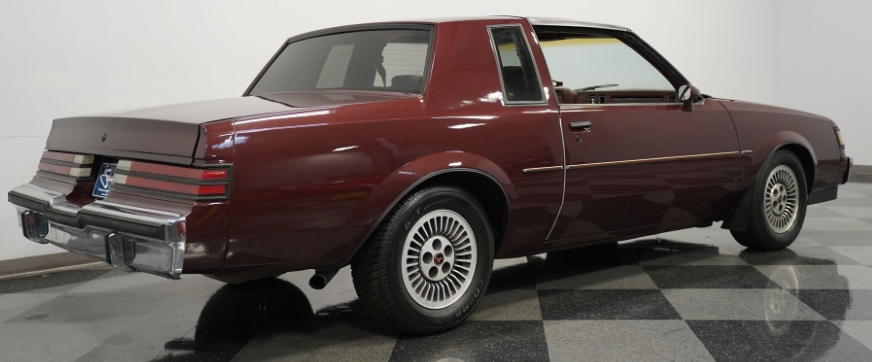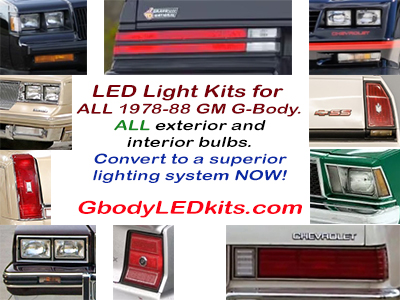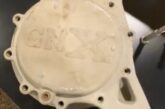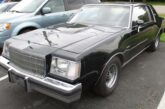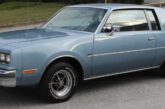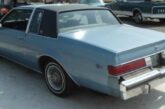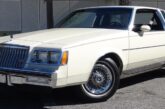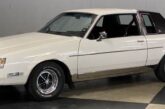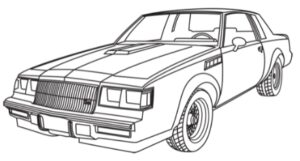In the automotive landscape of 1984, the American performance car was cautiously re-emerging from the doldrums of the Malaise Era. While a few V8-powered stalwarts were flexing their reviving muscles, one of the most exciting developments came from an unlikely source: Buick. Known more for its comfortable, near-luxury sedans favored by a more mature clientele, the division was secretly building a performance dynasty on its mid-size, rear-wheel-drive G-body platform. The 1984 Buick Regal was not a single entity but a spectrum of four distinct personalities, ranging from a placid boulevard cruiser to the menacing, black-clad legend that would define an era. Understanding the nuances between the base Regal, Regal Limited, Regal T-Type, and the iconic Grand National is to understand a pivotal moment in American automotive history.
The Foundation: 1984 Buick Regal (Base Model)
The standard 1984 Buick Regal was the bread and butter of the lineup, a handsome and comfortable personal luxury coupe that perfectly embodied the brand’s core values. It was designed for the traditional American car buyer who prioritized a smooth ride, quiet cabin, and classic styling over corner-carving abilities or neck-snapping acceleration.
Specifications and Features:
- Standard Engine: The workhorse 3.8L (231 cubic inch) naturally aspirated V6 engine, producing a modest 110 horsepower and 190 lb-ft of torque. It was carbureted, reliable, and built for effortless cruising, not high-rpm thrills.
- Optional Engines: Buyers could opt for a larger 4.1L V6 or even a 5.0L (305 cubic inch) V8 sourced from Oldsmobile, which offered a healthier 140 horsepower. A deeply unpopular and troublesome 4.3L V6 diesel was also technically available.
- Transmission: A 3-speed automatic transmission was the standard pairing for most engines, reinforcing the car’s relaxed demeanor.
- Exterior: The base Regal featured a formal roofline, a prominent chrome waterfall grille, chrome bumpers, and full-length body side moldings. Standard wheels were simple steel units with wire-spoke hubcaps, a quintessential look for the era. The iconic Buick “Sweepspear” design cue was subtly integrated into the body lines.
- Interior: Inside, the base model was all about comfort. A plush cloth bench seat was standard, allowing for six-passenger capacity in a pinch, with a column-mounted gear selector. The dashboard was straightforward, with a horizontal speedometer and basic warning lights. Power amenities were optional.
The base Regal was a high-volume seller, a car for daily commutes, Sunday drives, and comfortable road trips. It was Buick doing what Buick did best: providing affordable, reliable, American-style luxury.
Production: The combined production for the base Regal and Regal Limited coupes was a substantial 218,024 units, making them a common sight on American roads.
The Step-Up in Comfort: 1984 Buick Regal Limited
For the buyer who wanted the Regal experience with an extra layer of opulence, there was the Regal Limited. This trim level was not about performance; it was purely an exercise in elevating the comfort and luxury appointments of the base model. It represented a bridge between Buick’s mid-size offerings and its larger, more prestigious Electra and LeSabre lines.
Specifications and Features:
- Powertrain: The Limited shared the exact same standard and optional engine lineup as the base Regal. Its differentiation was entirely in its trim and features.
- Exterior: The Limited distinguished itself with subtle but significant exterior upgrades. It often featured a standard vinyl landau roof, extra chrome trim around the windows and wheel arches, and specific “Limited” badging. The wire wheel covers were often of a more intricate design.
- Interior: The interior was the Limited’s true calling card. The standard seating was a 55/45 “Notchback” front seat, upholstered in deeply padded, pillow-top velour that was sinfully comfortable. Faux woodgrain trim adorned the dashboard and door panels, and a higher level of standard equipment often included power windows, power locks, and cruise control. It was designed to isolate the driver from the road, not connect them to it.
The Regal Limited was for the driver who valued tangible luxury over performance metrics. It was a statement of comfortable success, a personal sanctuary on wheels that looked and felt more expensive than it was.
The Quiet Threat: 1984 Buick Regal T-Type
Here is where the Regal’s personality split takes a dramatic turn. The T-Type (short for Touring Type) was Buick’s answer for the enthusiast who wanted serious performance without the flashy aesthetics. It was the ultimate sleeper, a wolf hiding in plain sight, armed with the most advanced V6 engine in any American production car at the time.
Specifications and Features:
- Engine: The heart of the T-Type was the revolutionary 3.8L V6 equipped with Sequential Fuel Injection (SFI) and a turbocharger. This legendary powerplant produced a staggering 200 horsepower and 300 lb-ft of torque. These were V8-beating numbers in 1984, making the T-Type quicker than a contemporary V8 Chevrolet Camaro or Ford Mustang GT.
- Transmission: This potent engine was mated to a mandatory, specially calibrated 4-speed 200-4R automatic transmission with a lock-up torque converter, allowing for both brutal acceleration and relaxed highway cruising.
- Suspension: The T-Type wasn’t just about straight-line speed. It came standard with the “Gran Touring” (RPO code Y56) suspension package. This included higher-rate springs, firmer shocks, and larger diameter front and rear sway bars. This transformed the Regal’s typically soft ride into a surprisingly taut and capable handling experience.
- Exterior: Visually, the T-Type was remarkably understated. Unlike the Grand National, it could be ordered in any available Regal color. It retained much of the standard chrome trim, could be had with or without a vinyl top, and often came with sporty, finned aluminum wheels. A subtle, bulged hood was the primary external clue to the potent machinery underneath.
- Interior: A T-Type could be optioned with a standard bench seat and column shifter, creating the ultimate sleeper configuration. However, most were equipped with bucket seats, a center console, and a full gauge package that included a tachometer and, crucially, a turbo boost gauge.
The T-Type was for the discerning enthusiast who appreciated technology and power but didn’t need to advertise it. It was a sophisticated performance machine, a gentleman’s express.
Production: Approximately 3,732 Regal T-Types (non-Grand National Turbo Regals) were produced in 1984, making them significantly rarer than their more famous black-clad sibling.
The Legend in Black: 1984 Buick Grand National
If the T-Type was the quiet threat, the Grand National was the public declaration of war on the performance establishment. While mechanically identical to the T-Type, the Grand National was a meticulously crafted package of image and attitude. It took the T-Type’s performance and wrapped it in a sinister, unforgettable aesthetic that would become legendary.
Specifications and Features:
- Powertrain and Suspension: The Grand National used the exact same 200 hp / 300 lb-ft 3.8L SFI Turbo V6, 4-speed automatic transmission, and Gran Touring suspension as the T-Type. Performance-wise, the two cars were identical off the showroom floor.
- Exterior: The difference was all in the presentation. The 1984 Grand National (RPO code WE2) was available in one color and one color only: Black. All exterior chrome trim—from the grille and headlight bezels to the window surrounds and wheel opening moldings—was blacked out. It featured a unique front air dam and a subtle decklid spoiler. Special aluminum wheels with black-painted inserts and “Grand National” center caps completed the menacing look.
- Interior: The interior was also a bespoke affair. The only choice was a two-tone charcoal and gray cloth interior with Lear-Siegler sport bucket seats featuring embroidered “6” logos on the headrests. A sport steering wheel, center console with a floor shifter, and the same full instrumentation as the T-Type were standard.
The Grand National was a brilliant piece of marketing. Buick understood that for many buyers, the image of performance was as important as the performance itself. The all-black, “Darth Vader” persona was an instant hit, creating an identity that transcended mere specifications. It wasn’t just a fast car; it was a Grand National.
Production: Exactly 2,000 Grand Nationals were built in 1984. This limited production number, combined with its iconic status, cemented its place as a future collectible from the moment it was new.
Conclusion: A Spectrum of Choice
In 1984, the Buick Regal nameplate represented a remarkable range of automotive personalities. The base Regal and Regal Limited upheld the brand’s long-standing tradition of comfort and accessible luxury. They were the dependable, quiet cruisers that formed the financial backbone of the line. But orbiting this conventional core were the T-Type and the Grand National—two cars that looked to the future. They proved that a V6 could not only compete with but dominate a V8, and that advanced technology like sequential fuel injection and turbocharging was the new path to performance.
While the T-Type offered this power with stealthy subtlety, the Grand National offered it with theatrical bravado. They were two sides of the same high-performance coin, sharing identical hearts but appealing to vastly different sensibilities. The 1984 model year was the moment Buick perfected this formula, setting the stage for the even more powerful intercooled legends of 1986-87 and creating a legacy that continues to fascinate enthusiasts to this day.
.
.


















